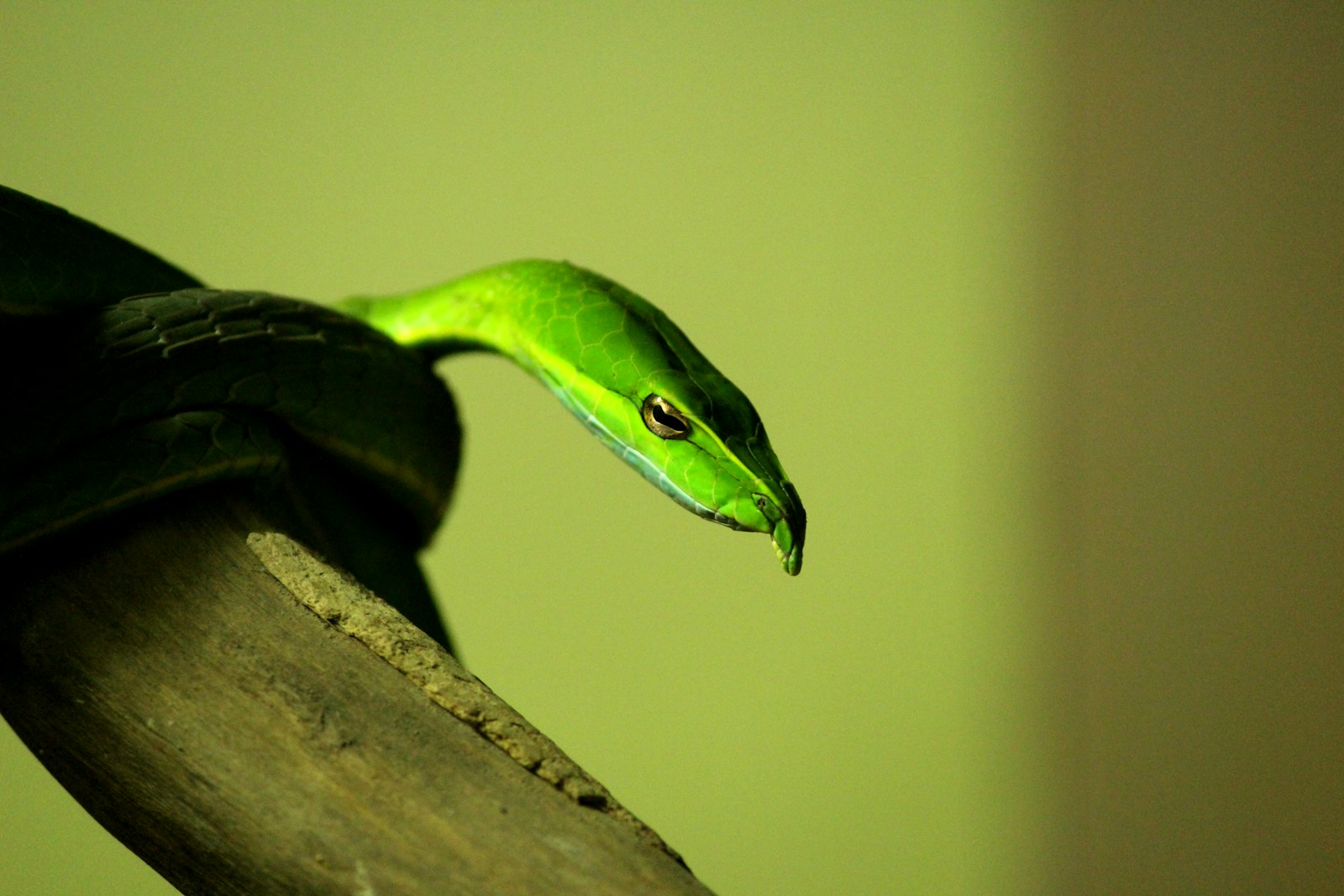In the dense rainforests and tropical environments across parts of Asia, a remarkable predator employs one of nature’s most patient hunting strategies. The vine snake, with its pencil-thin body and extraordinary adaptations, can remain perfectly still for hours at a time, creating an almost perfect illusion of being nothing more than a slender branch or vine hanging from vegetation. This masterful ambush predator demonstrates one of the most impressive displays of patience and stillness in the animal kingdom, often leaving observers wondering if they’re looking at a living creature or simply another part of the forest. This incredible ability to maintain complete immobility isn’t just fascinating—it’s a sophisticated evolutionary adaptation that has helped these specialized hunters survive for millions of years.
The Vine Snake’s Identity
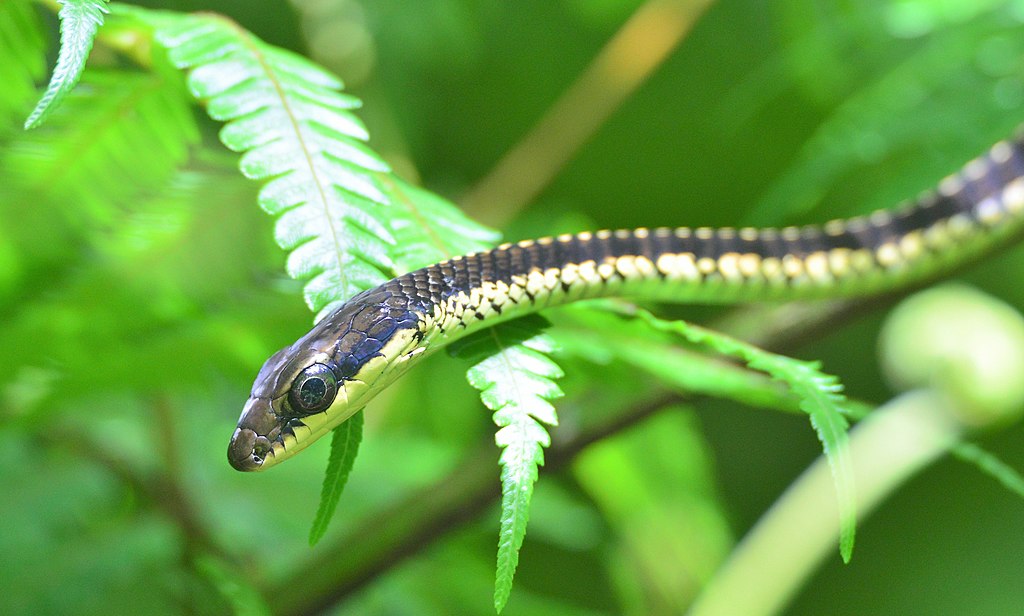
When discussing snakes that can hang motionless for hours, we’re primarily referring to the vine snake species, with the Asian vine snake (Ahaetulla prasina) being one of the most notable examples. These slender reptiles belong to the Colubridae family, the largest snake family that includes about two-thirds of all known snake species. Vine snakes are characterized by their extremely thin bodies, elongated heads with pointed snouts, and horizontal pupil slits that provide exceptional binocular vision. Their bodies are typically bright green, matching the vegetation where they hunt, though some species display brown, gray, or yellowish coloration depending on their specific habitat. These specialized hunters are found throughout Southeast Asia, India, and parts of China, thriving in tropical forests where their camouflage and hunting strategy work to perfection.
The Evolutionary Purpose of Stillness
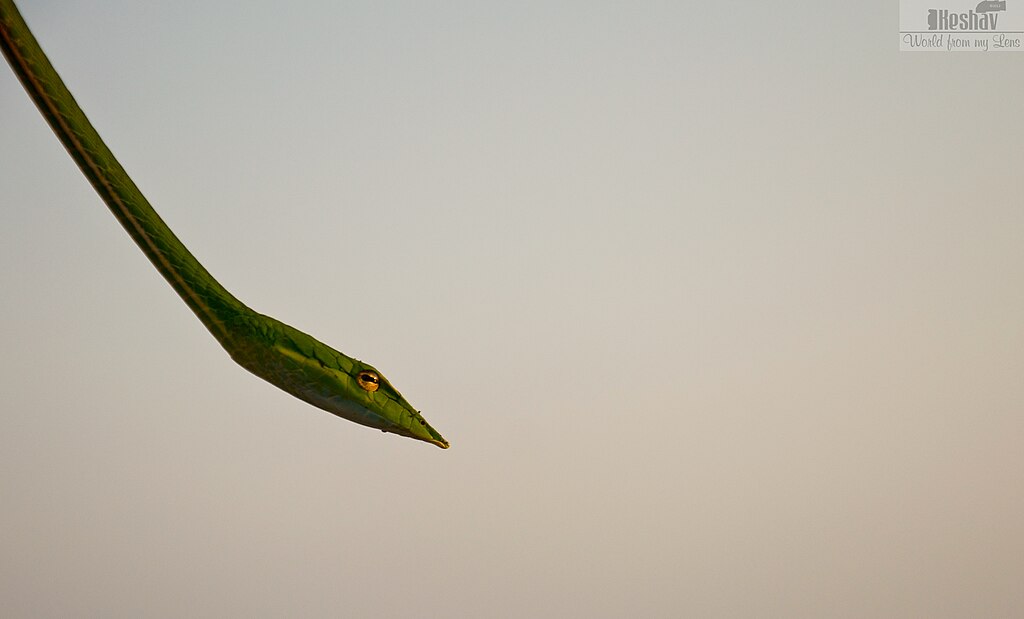
The vine snake’s remarkable ability to remain motionless for extended periods serves a critical evolutionary purpose: ambush predation. Unlike active hunters that chase down prey, vine snakes have evolved to be the ultimate “wait and strike” predators, conserving energy while maximizing hunting success. This stillness isn’t just a behavioral choice but a necessary survival strategy dictated by their specialized anatomy. Their extremely thin bodies lack the muscular power needed for pursuing prey over distances or constricting victims. Instead, evolution has favored their development as perfect mimics of vines and branches, with bodies so lightweight and slender that they can balance on the thinnest twigs without causing noticeable movement. This evolutionary adaptation allows them to position themselves along paths frequently traveled by their preferred prey—lizards, frogs, and small birds—and strike with precise timing and minimal energy expenditure.
The Physiology Behind the Stillness
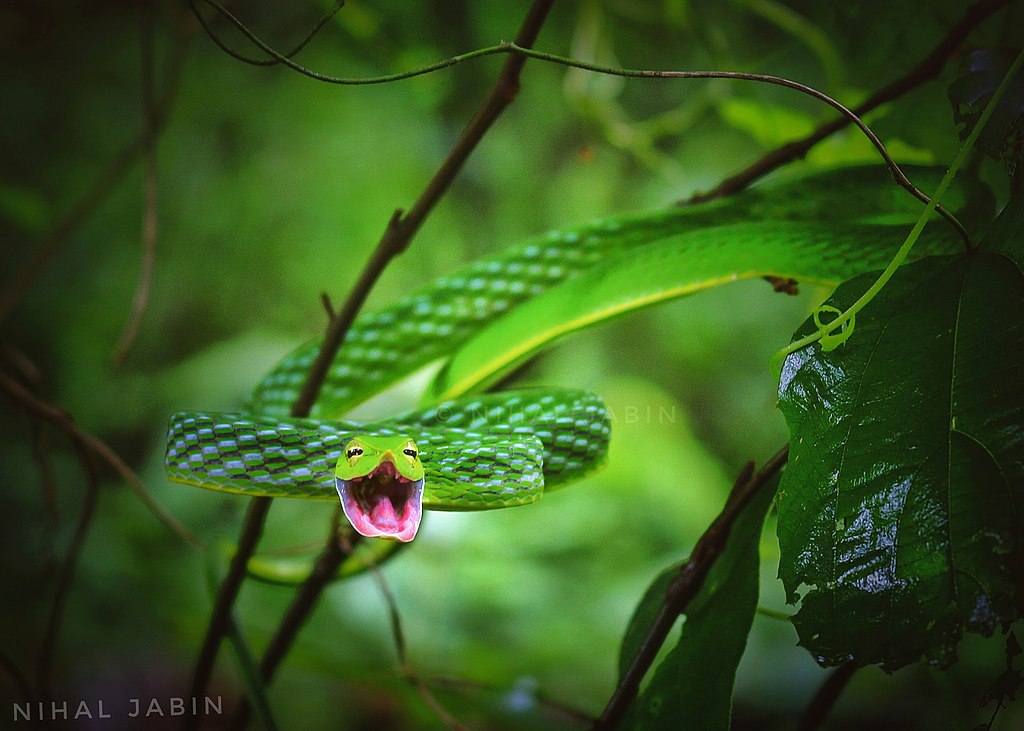
The vine snake’s ability to remain motionless for hours comes from several remarkable physiological adaptations. Unlike mammals, snakes have extremely slow metabolisms and can function with much less oxygen and energy, allowing them to remain still without fatigue. Their specialized musculature includes highly developed stabilizing muscles that lock their body in position, much like a tripod secures a camera. The vine snake’s spine contains a higher number of vertebrae than many other snake species, giving it exceptional flexibility and stability when positioned in mimicry of a vine. Perhaps most impressive is their cardiovascular adaptation—vine snakes can dramatically slow their heart rate during these motionless periods, reducing the tiny pulses of movement that might otherwise betray their presence to prey. These combined adaptations create a perfectly still hunter that barely needs to breathe while waiting for the perfect moment to strike.
Perfect Camouflage Complements Stillness
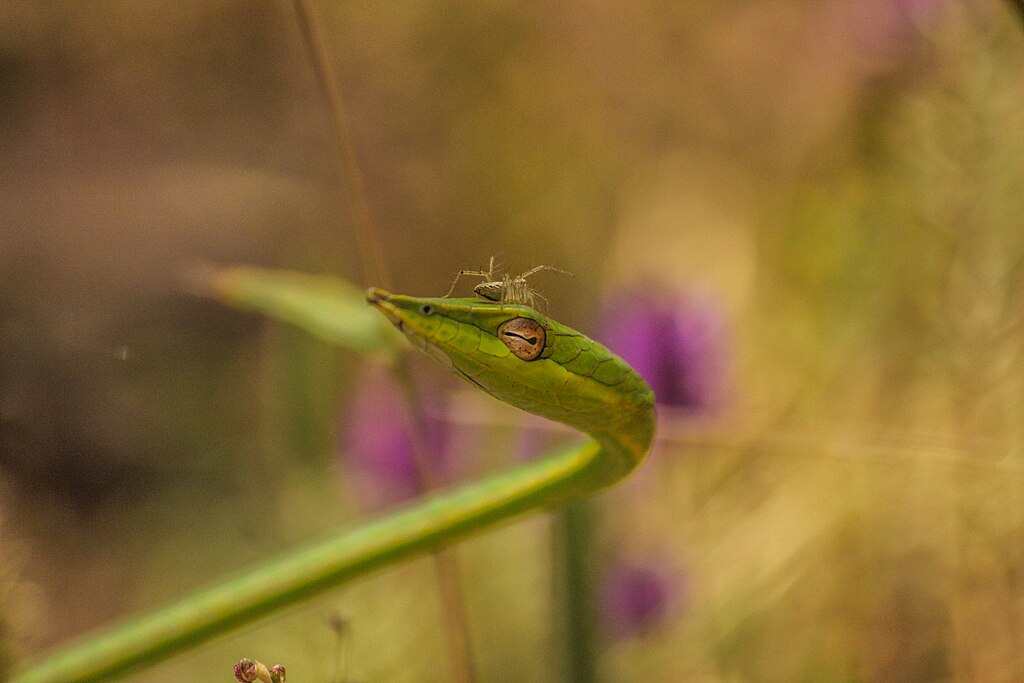
The vine snake’s ability to remain motionless would be far less effective without its exceptional camouflage. Their bodies are perfectly adapted to blend into their forest environment with coloration that precisely matches the vegetation where they hunt. Most species display a bright green color that mimics fresh foliage, while others exhibit brown or grayish hues that match dried or decaying plant material. Beyond color, their body shape completes the disguise—the extremely thin, elongated form creates an outline nearly identical to vines or thin branches. Some species even have subtle patterns that mimic light and shadow patterns on foliage. When the snake positions itself hanging from a branch, its body sometimes takes on a gentle curve that exactly replicates the natural droop of vines in the forest. This comprehensive camouflage system works in perfect concert with their stillness to create what might be nature’s most effective visual deception.
The Hunting Strategy
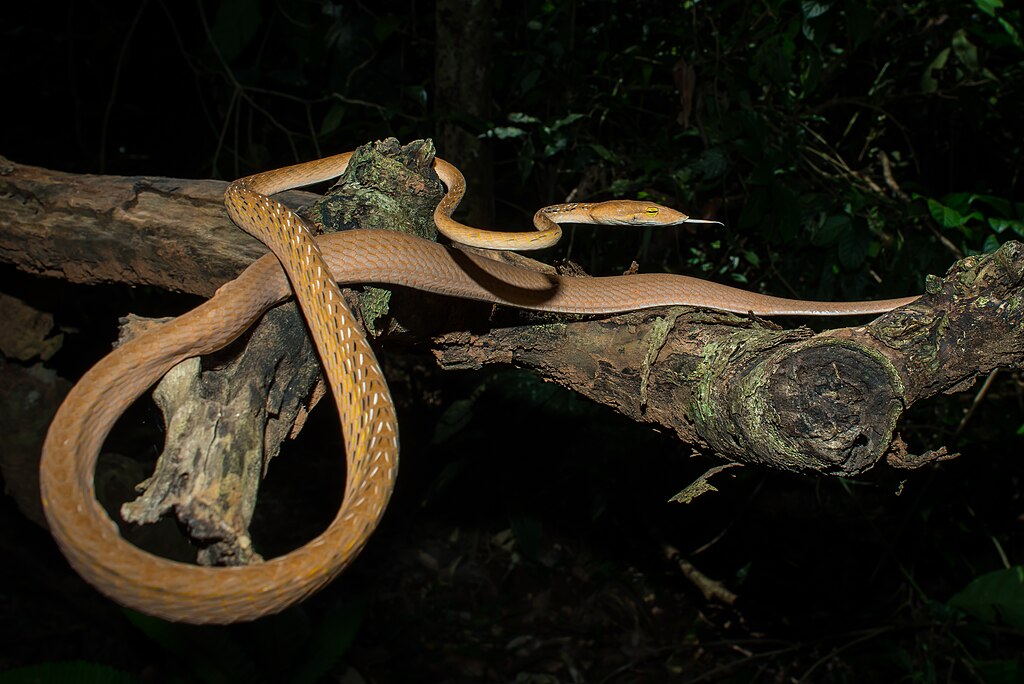
The vine snake’s hunting technique represents one of nature’s most refined examples of the ambush strategy. After selecting a promising hunting location—typically along paths frequently traveled by lizards or birds—the snake will position itself by hanging from a branch or vine, often in a characteristic “S” shape that allows for a powerful forward strike. Once positioned, the waiting game begins, with the snake capable of maintaining perfect stillness for up to eight hours or more. Their eyes, with horizontal pupils that provide excellent depth perception and binocular vision, remain the only part of their body that moves, scanning the environment for approaching prey. When a potential meal comes within striking distance—which can be surprisingly close due to their excellent camouflage—the snake launches forward with surprising speed and precision. Unlike many other venomous snakes, vine snakes don’t immediately release their prey after striking; instead, they maintain their bite while their mild venom begins to work, eventually consuming their immobilized victim whole.
Specialized Venom Delivery System
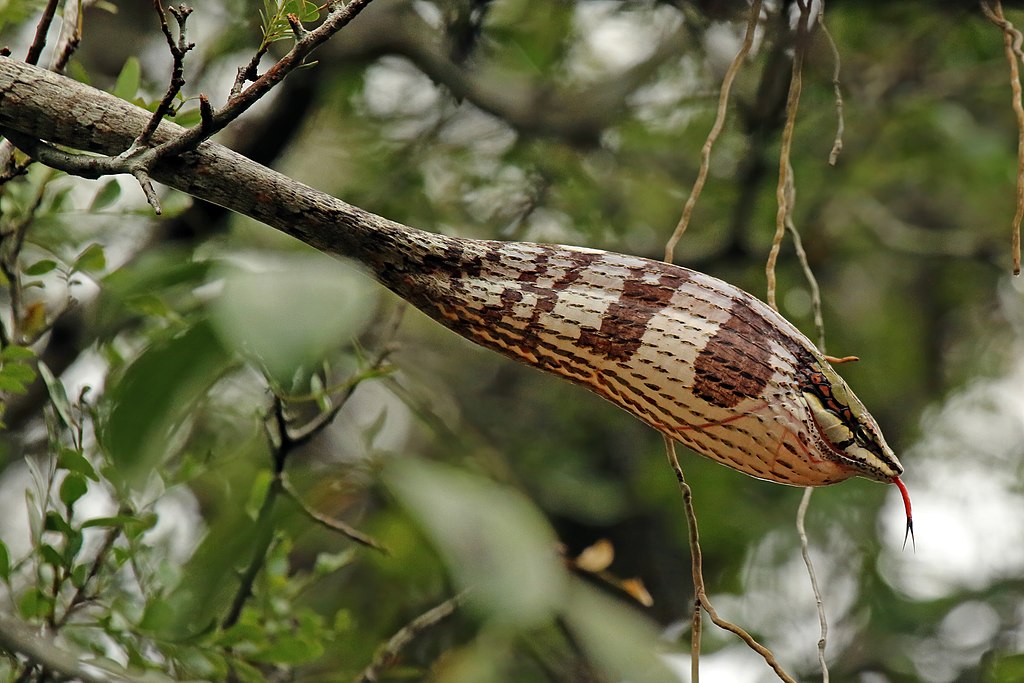
The vine snake possesses a specialized venom delivery system that perfectly complements its patient hunting strategy. Unlike front-fanged venomous snakes like cobras or vipers, vine snakes are opisthoglyphous, meaning they have enlarged, grooved teeth located toward the back of their upper jaw. When they bite prey, they often chew slightly to ensure these rear fangs make contact and deliver venom effectively. The venom itself is relatively mild compared to that of other venomous snakes but is perfectly suited for their preferred prey of lizards, frogs, and small birds. It works primarily as a paralyzing agent, immobilizing the prey while causing minimal tissue damage, which facilitates easier swallowing. This specialized venom system represents another adaptation that supports their hunting strategy—rather than delivering a single powerful dose of venom and waiting for prey to die elsewhere, vine snakes maintain control of their catch throughout the envenomation process, reducing the chance of losing a meal they worked so patiently to capture.
Remarkable Visual Capabilities
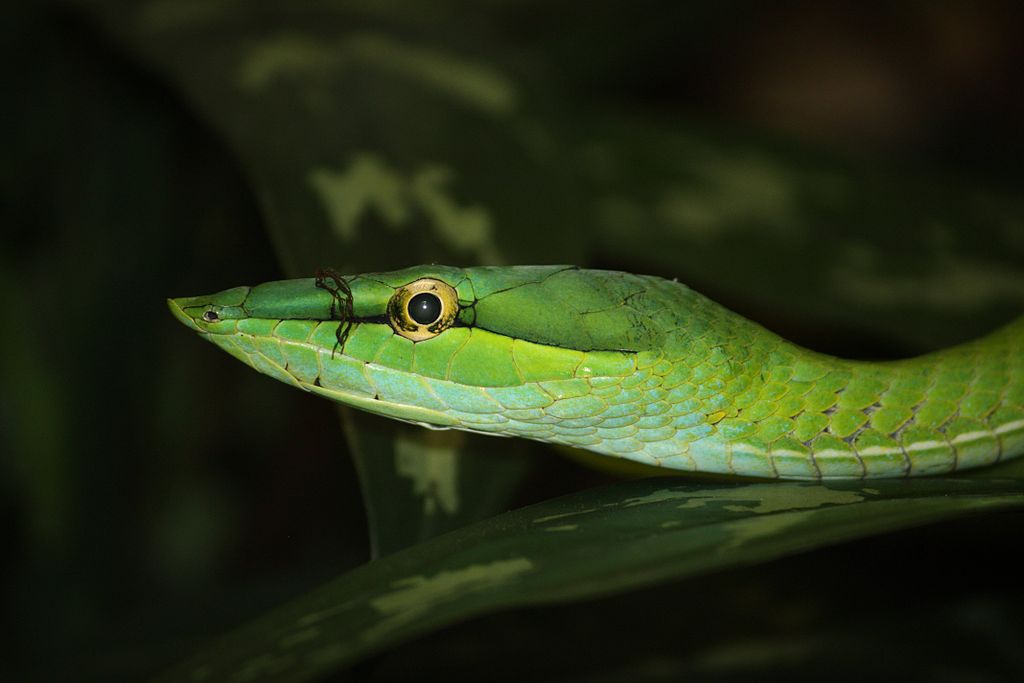
The vine snake’s eyes tell the story of a highly specialized visual predator. Unlike the vertical slit pupils found in many nocturnal snakes, vine snakes possess horizontal pupils that provide exceptional binocular vision and depth perception—crucial abilities for a predator that strikes with precision from a stationary position. Their eyes are positioned toward the front of their elongated head, providing significant overlap in their visual fields and creating true stereoscopic vision that allows for accurate distance judgment. This visual adaptation is relatively rare among snakes but essential for the vine snake’s hunting strategy. While maintaining their motionless posture, these snakes can move their eyes independently to scan their surroundings without betraying their presence with body movements. Their visual acuity is believed to be among the highest of all snakes, allowing them to detect the subtle movements of small prey against complex forest backgrounds. This exceptional vision complements their patience, ensuring that when they finally break their stillness to strike, they do so with remarkable accuracy.
Energy Conservation Masters

The vine snake’s ability to remain motionless represents an extraordinary energy conservation strategy that allows these specialized predators to survive on relatively infrequent meals. By remaining still and waiting for prey to come within striking distance, vine snakes expend minimal energy compared to active hunters that must chase down their food. Their slow metabolism—even by reptilian standards—means they require significantly less food than similarly sized active predators. Research has shown that vine snakes can reduce their metabolic rate by up to 70% during these motionless hunting periods, essentially entering a state of semi-torpor while remaining fully alert and ready to strike. This energy efficiency extends to their digestion process as well; after successfully capturing prey, vine snakes typically retreat to a secure location where they remain relatively inactive for days while digesting. This comprehensive energy conservation strategy allows them to survive in environments where prey may be sporadically available, making patience not just a hunting tactic but a fundamental survival strategy.
Different Species, Similar Abilities
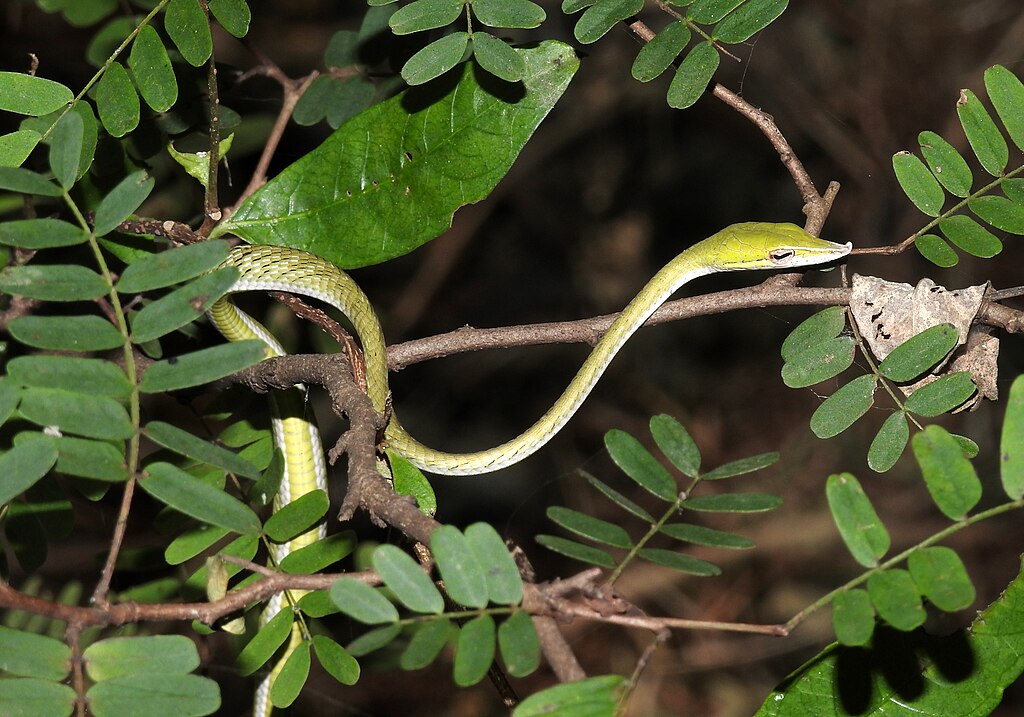
While the Asian vine snake (Ahaetulla prasina) is often the poster child for this remarkable ability to hang motionless, several related species demonstrate similar adaptations. The African vine snake (Thelotornis kirtlandii) displays nearly identical behavior in the forests of sub-Saharan Africa, often hanging motionless for hour-long stretches while waiting for lizards and birds. The American vine snake (Oxybelis fulgidus), found in tropical forests from Mexico to Bolivia, has independently evolved the same hunting strategy, demonstrating convergent evolution driven by similar ecological pressures. The Paradise Tree Snake (Chrysopelea paradisi), while better known for its gliding ability, also employs motionless hunting tactics when stalking prey in the canopy. Each of these species has developed slightly different specializations in terms of preferred habitat, exact prey items, and specific hunting positions, but all share the core adaptation of extraordinary stillness. This parallel evolution across continents highlights how effective this specialized hunting strategy has proven across tropical forest ecosystems worldwide.
Behavioral Flexibility Despite Stillness
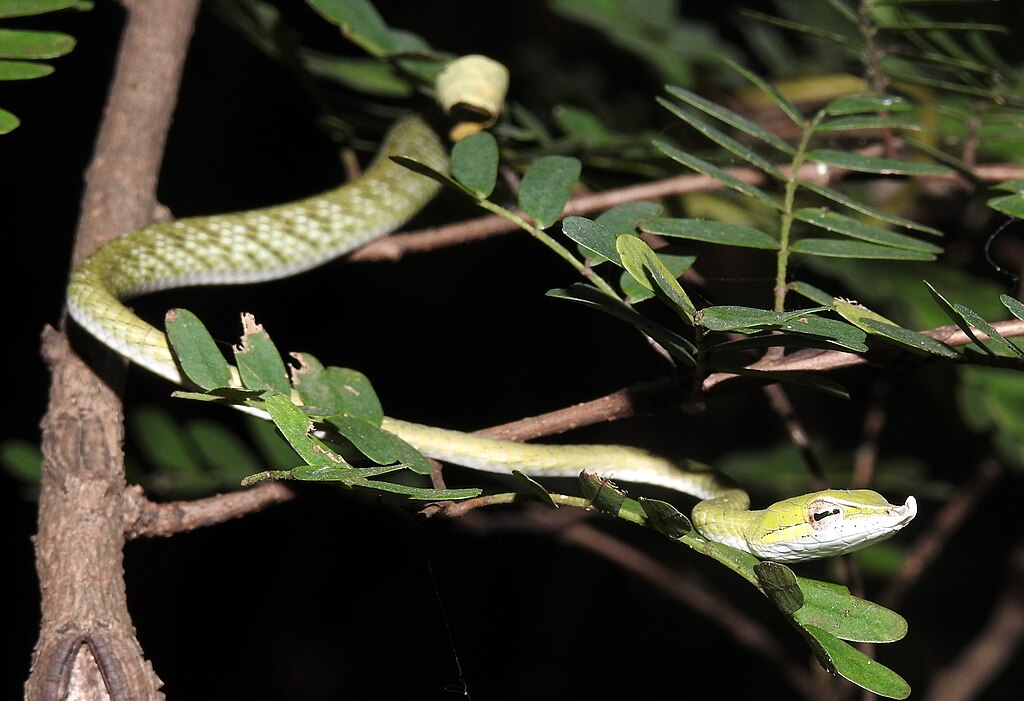
Despite their reputation for motionless hunting, vine snakes display remarkable behavioral flexibility when circumstances require it. While they prefer the energy-efficient ambush strategy, observations in the wild have shown that when prey is scarce or competition is high, these snakes can switch to active foraging behavior. During these periods, they move slowly through vegetation, using their exceptional vision to locate potential prey. Some species have been observed actively pursuing prey for short distances when the opportunity presents itself, particularly in cases where the initial strike misses. Interesting behavioral variations exist among different vine snake species as well. For example, some species are primarily diurnal (active during daylight), while others hunt during twilight hours when their camouflage remains effective but nocturnal prey begins to emerge. Perhaps most surprising is their adaptability in hunting location selection—researchers have documented vine snakes learning to position themselves near flowers frequented by nectar-feeding birds or along the travel routes of lizards, showing that their seemingly simple “hang and wait” strategy actually involves sophisticated decision-making processes.
Threats to These Stillness Specialists
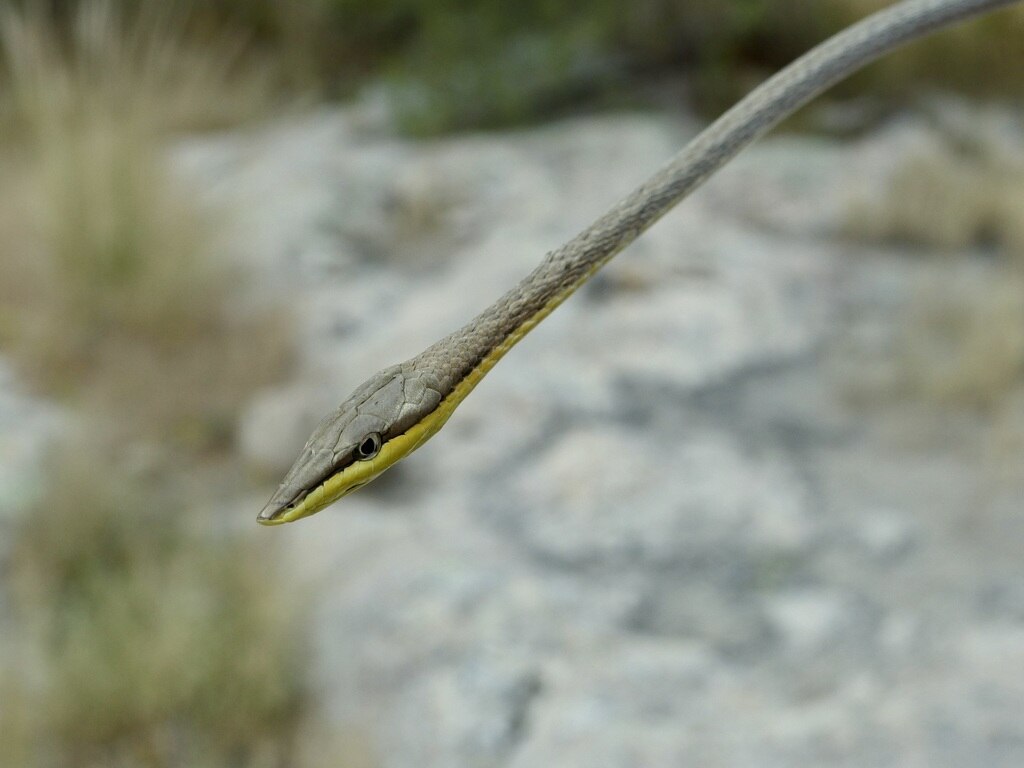
The highly specialized vine snakes face significant threats in the modern world, with habitat destruction representing the most serious challenge to their survival. Deforestation across their native ranges in Asia, Africa, and the Americas disrupts the complex forest ecosystems these specialized hunters rely upon. Their extreme adaptation for life in dense vegetation means they are particularly vulnerable to habitat changes; without appropriate branches and foliage to support their unique hunting strategy, they cannot effectively capture prey. Climate change poses another significant threat, as alterations in temperature and precipitation patterns affect both the vine snakes and their prey species. Additionally, their slender bodies and deliberate movements make them vulnerable to predation when on the ground or moving between trees. In some regions, vine snakes are also collected for the exotic pet trade, placing additional pressure on wild populations. Conservation efforts focused on preserving intact forest ecosystems represent the best hope for ensuring these remarkable reptiles can continue their patient hunting strategy for generations to come.
Observing the Masters of Patience
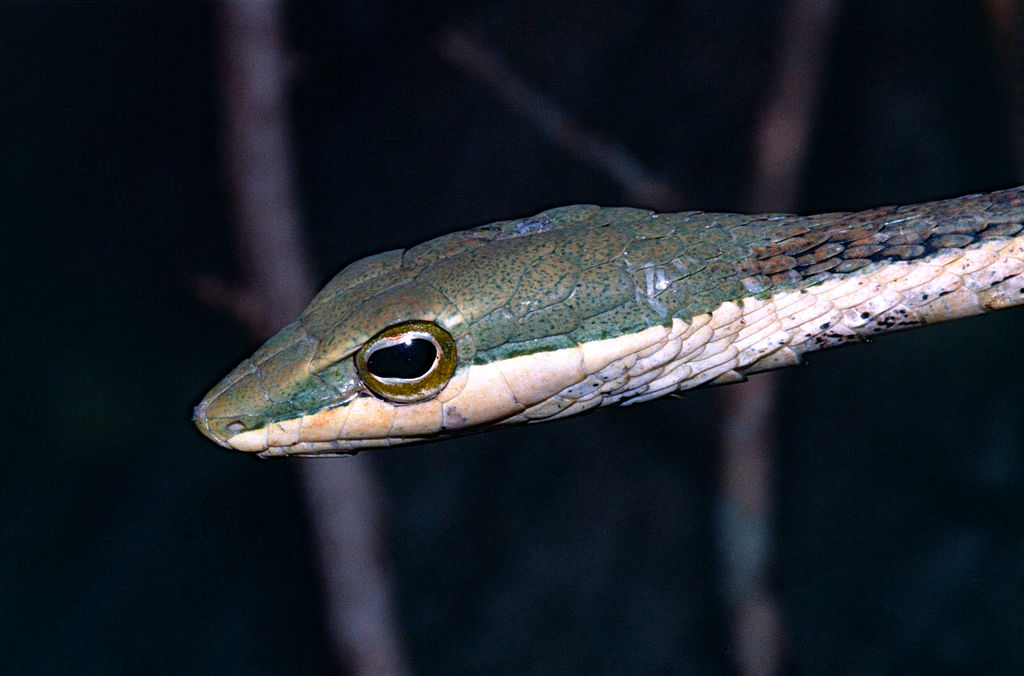
Spotting a motionless vine snake in the wild represents one of the greatest challenges for wildlife observers and photographers. Their exceptional camouflage and stillness mean that even experienced herpetologists often walk right past these snakes without noticing them. The best approach for observation involves slow, patient movement through appropriate habitat while carefully scanning vegetation at eye level and above. Most successful observations occur when the snake makes a slight movement or when its distinctive head shape is recognized among the foliage. For those lucky enough to spot a vine snake in its motionless hunting pose, the proper etiquette is to maintain distance and minimize disturbance. Quick movements or touching the vegetation where the snake is positioned will almost certainly cause it to retreat, ending the rare opportunity to witness this remarkable behavior. Wildlife photographers attempting to document this behavior often need to spend days in suitable habitat before successfully capturing images of this master of stillness in action.
Cultural Significance and Folk Beliefs
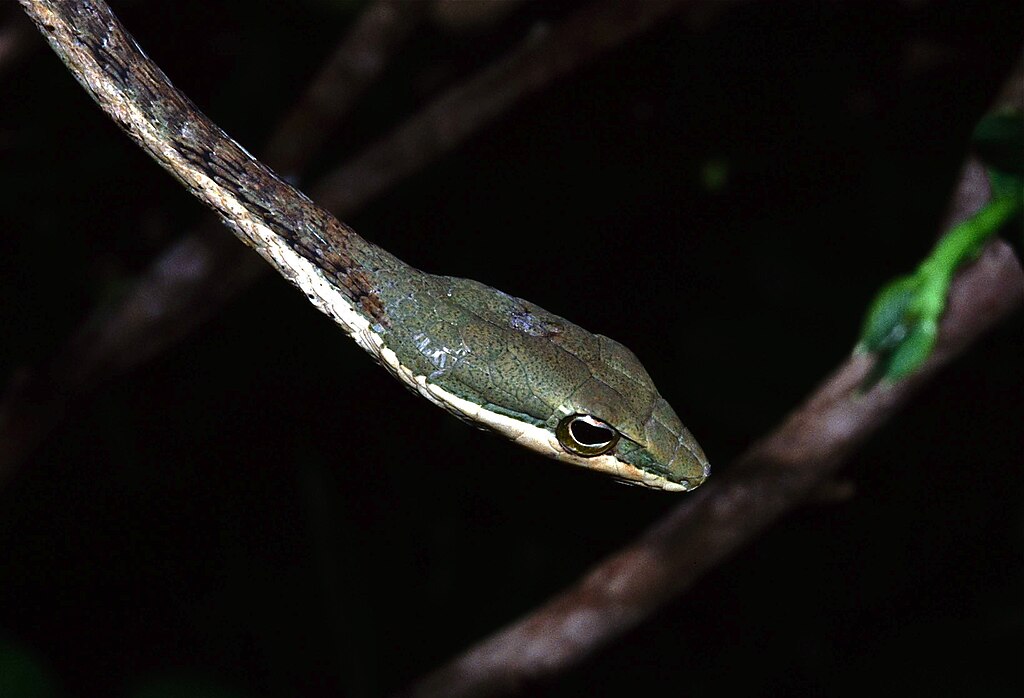
The vine snake’s extraordinary stillness and camouflage have made it the subject of numerous cultural beliefs and superstitions throughout its range. In parts of Southeast Asia, some indigenous communities believe these snakes possess supernatural patience and view them as symbols of mindfulness and the virtue of waiting for the right moment to act. In certain regions of India, folk tales speak of vine snakes as forest guardians that remain motionless while watching over sacred groves. Their ability to appear suddenly—seemingly materializing out of nowhere when they finally move—has led to beliefs in some cultures that they can become invisible or transform between snake and plant. Despite their mild venom, fear and misunderstanding have sometimes led to persecution; in some communities, vine snakes are incorrectly believed to be highly dangerous to humans. Among wildlife enthusiasts and nature photographers, however, successfully spotting a vine snake in its motionless hunting pose is considered a badge of honor, representing the observer’s own patience and attentiveness to nature’s subtle details.
Conclusion
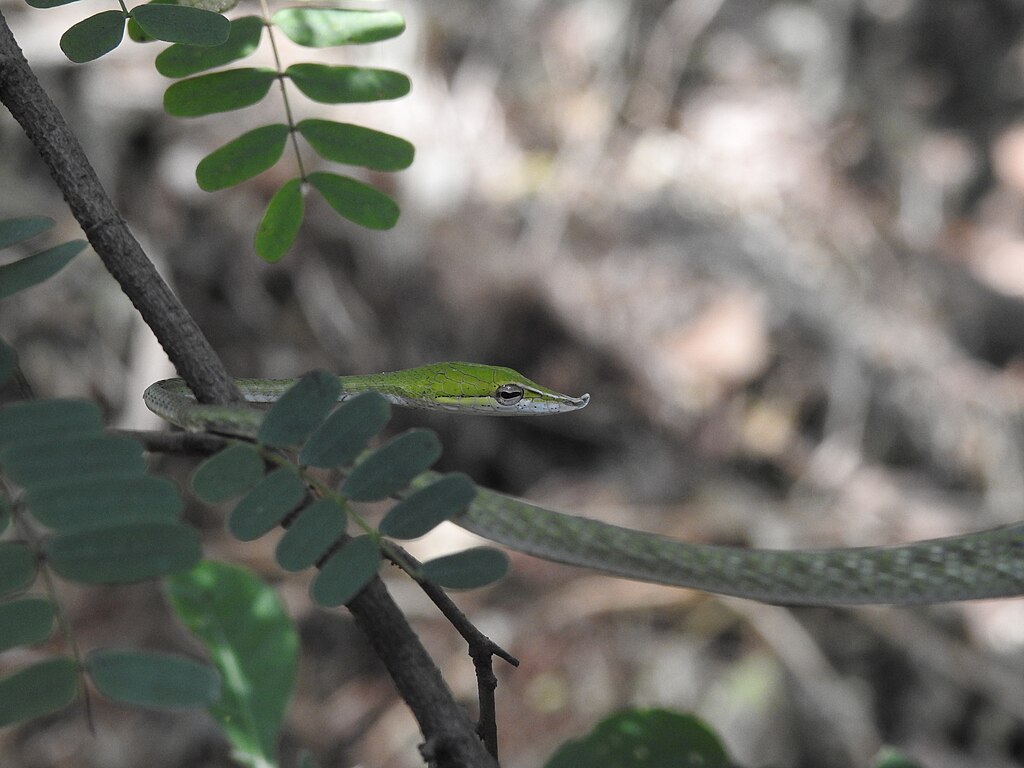
The vine snake’s remarkable ability to hang motionless for hours represents one of nature’s most specialized hunting adaptations. Through a combination of extreme physiological adaptations, perfect camouflage, exceptional vision, and evolved patience, these slender predators have perfected a hunting strategy that maximizes efficiency while minimizing energy expenditure. Their specialized bodies—from their pencil-thin form to their horizontal pupils—work in concert to create what might be nature’s most effective sit-and-wait predator. As deforestation continues to threaten their habitat across multiple continents, conservation of intact forest ecosystems becomes increasingly important for ensuring the survival of these masters of stillness. For those fortunate enough to witness a vine snake in its motionless hunting pose, the experience offers a rare glimpse into the extraordinary adaptations that evolution can produce when specialization is taken to its extreme.

